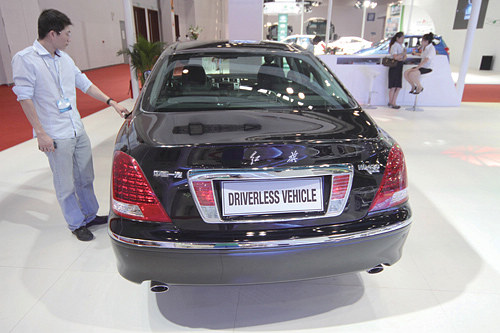|
 |
|
ONE OF A KIND: The Hongqi brand driverless car demonstrates China's latest unmanned driving technologies at the China National Convention Center from September 6 to 10 (IC) |
The experiment was sponsored by Hongqi Group, one of China's major vehicle manufacturers, and the vehicle achieved an average speed of 87 km per hour. "We set a maximum speed of 110 km per hour, but everything else was automatic," said Dai. "It stepped on the gas, put on the brakes, made turns and changed paths automatically."
The vehicle overtook other cars on the road 67 times during the experiment. But it was safe because it was programed to step on the brakes the moment it is too close to another vehicle. "Generally the reaction time for machines can reach 40 milliseconds, much shorter than the time human beings need for quickest reaction—about 500 milliseconds," said Dai.
Birth of Hongqi HQ3
The vehicle, Hongqi HQ3, made a sensation in its 2007 debut, because China developed the entire system for it.
"China won't have a say in the field if we can't develop our own unmanned automobiles," said He Hangen, professor at the National University of Defense Technology and another member of the Hongqi HQ3 research team.
At an international seminar on unmanned driving He attended in 1996, Japanese experts turned down the request of Chinese researchers to join in a proposed multinational research project because China hadn't yet developed its own unmanned vehicles. From then on, He and Dai have led the team to make a series of breakthroughs in key technologies and built from scratch China's first unmanned automobile in 2001.
Some overseas experts at that time agreed that 70 km per hour was the speed cap for unmanned automobiles because of a 200-millisecond delay in reaction of the unmanned control system, but China's first driverless car could drive at a speed of 76 km per hour. He and his team solved the problem by integrating intelligent control solutions into an advanced cognitive analysis system, which made the "brain" of their vehicle capable of multi-task processing.
In 2003, the team set a world record when their vehicle reached a speed of 170 km per hour.
Now, while competing with international peers, Chinese experts on driverless technologies are sticking to a different way. Unlike foreign unmanned vehicles which rely on GPS information and digital mapping, China's Hongqi HQ3 uses an environment sensing system and an intelligent decision making and control system.
With breakthroughs in intelligent automobile technologies, vehicle manufacturers, software providers and telecom operators have all invested in a future when intelligent vehicles become affordable.
Currently, intelligent driving technologies are used to make driving a simpler task, enhance the safety of automobiles and reduce car accidents.
IT applications in vehicles, for instance, are bringing huge changes to the traditional automobile industry. A new model equipped with a "smart" navigation system, which is powered by WCDMA mobile network, is rolling off the assembly line of Shanghai Automotive Industry Corporation Group. And private automaker BYD has already introduced the S6 model featuring some intelligent functions, such as a digital security system, a voice electronic navigation system and a car reserving camera installed on the rear.
Red light still on
Scientists have to overcome a number of obstacles before anyone drives home a real intelligent car. Limited cognition capacity of the current generation computers could be the biggest one.
"Although intelligent vehicles are already powerful in collecting information, how to process a sea of information to make the right decisions is a hard nut to crack," said Zhang Zhaotian, Deputy Director of the Department of Information Sciences under the NSFC. "Computers can process numbers well, but will be outperformed by kindergarten kids when the task is about cognition."
Zhang gave the example of difficulties in distinguishing shadows from actual obstacles with cameras. "It could take too much time even if a right decision is finally made," he said.
Inconsistent and unstable performance of unmanned vehicles also accounts for a lack of confidence in such technologies from both manufacturers and customers. "Driverless technologies have to be improved to help intelligent vehicles adapt to complicated environments," said He Kezhong, professor in the Department of Computer Science and Technology at Tsinghua University.
Reliability and safety are big issues for unmanned vehicles. But the camera in the sensing system, for example, can only work between 0 and 50 degree Celsius, hardly reliable in all circumstances. "New technologies and materials are badly needed in the field. Until these problems are solved, automobile companies and customers won't accept intelligent vehicles," He Kezhong said.
A lack of communication and cooperation between research institutes and automobile companies is another problem. "It is impossible to work out standards for driverless technologies without participation of major auto companies," said He. "But such technologies are crucial to the future competence of auto companies once they reach full maturity." | 